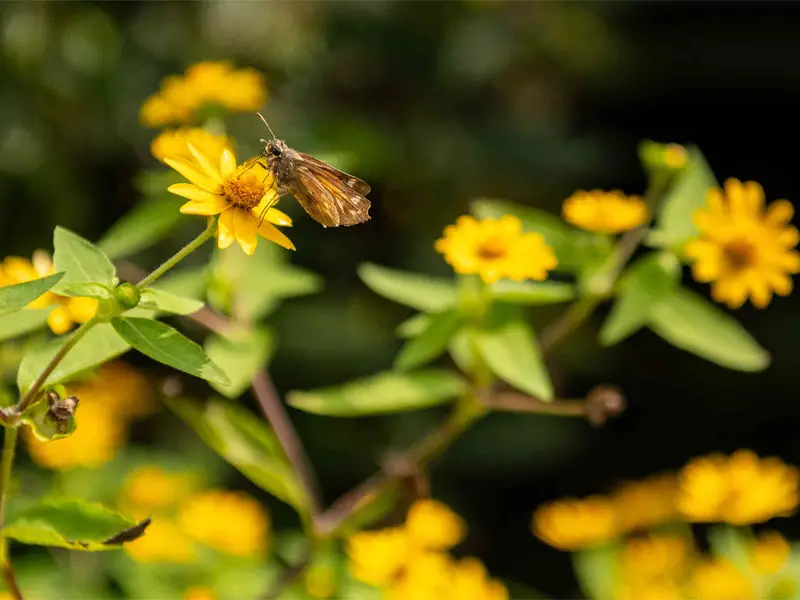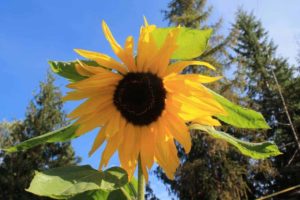
Melampodium is a variety of plants closely related to sunflowers.
As part of the sunflower family, it is mainly known as a beautiful yellow petaled, daisy-like flower with luscious green leaves.
Commonly known as Butter Daisy, this plant comes in various forms that all have similar characteristics.
The Butter Daisy is known to be one of the easiest plants to grow and maintain.
Its scientific name is Melampodium Paludosum, which can be very hard to say hence why its common name of “Butter Daisy” is more widely used.
This plant is native to the tropical regions of North America, such as New Mexico.
| Scientific Name | Melampodium Paludosum |
| Common Names | Butter Daisy, Melampodium divaricatum |
| Hardiness | 2 through to 11 |
| Indoor or Outdoor Plant? | Indoor plant and Outdoor plant |
| Sun Exposure | Full Sun |
| Water | Moderate |
| Size | 1 to 2 feet tall (12” to 24”) |
| Soil Type | Well-drained, sandy |
| Soil pH | 6.0 to 8.0 |
| Flower | Sunflower family |
| Growing Difficulty Level | Easy |
Melampodium Appearance and Characteristics

These gorgeous flowers look like miniature sunflowers despite their comparison to a daisy.
Each flower is usually only 1 inch wide, with strong, bright yellow petals, a dark golden center, and deep green leaves.
This beautiful plant makes the perfect addition to any garden.
The stems on one variety of the Melampodium plants can become a very dark green color and, in some cases, can almost look black.
This has given the stem of the plant the nickname “black foot”.
Because Melampodium plants are so gorgeous, they are generally used around the edges of gardens as they have such beautiful foliage and brightly colored flowers.
More Varieties of the Melampodium

As previously mentioned, Melampodium has a large variety of its kind.
There are over 40 different types of plants, all sharing very similar appearances and characteristics.
Melampodium plants are all slightly different in shape, and their petals are multiple shades of yellow and gold.
Their sizes range from tiny dwarf species that are only 7.5cm to 13cm tall to larger varieties that are 0.5m tall.
Their other species, such as the Butter Daisy, also have some fun names.
The three well-known ones are Lemon Delight, Melanie, and Showstar.
They are all very similar in appearance display various shades of yellow petals.
Their leaves are also different from Melampodium, mainly due to their size and how much foliage they grow.
Melampodium Growing Guide

The best time to grow Melampodium plants successfully is spring, summer, and fall.
You can begin the growing process inside during the winter before moving them out into the garden when days get longer and the weather warmer.
These gorgeous flowers should still stand through winter once established outdoors.
They will just need to be significantly cut back during early spring, ready for another season of blooming.
Usually, you want to leave 2 to 3 inches still standing above ground level.
The flowers will begin to bloom roughly 60 days after sewing.
To summarize, the Melampodium can be planted in medium-sized containers indoors, keeping them 10 inches apart and planted in well-drained soil.
Make sure they are watered regularly, letting the soil dry in between each water.
After six to eight weeks, they can be transplanted outside.
Gardeners should plant them in full sun, which is where they will thrive the most.
Usually used as edging, their foliage looks beautiful on the outskirts of your garden bed, keeping the area looking full yet tidy.
Again, keep watering regularly but letting the soil dry each time.
Laying sand instead of mulch over your soil is an alternative option and does encourage growth and prevent powdery mildew from forming.
Water
Regular watering is best for the Melampodium, although it prefers the soil slightly dry between each water.
They like to be in direct sunlight, which means you need to pay extra attention to watering.
Keep watering regularly, but it is important not to drown your plant.
Make sure your soil has dried out completely between watering sessions.
Light
These gorgeous flowers are part of the sunflower family, so what do they need? Sunlight, and plenty of it!
They can grow well in hotter conditions as long as they are watered regularly.
Sometimes they may need assistance standing upright as they begin to mature as they can get heavy, but this is not always the case.
If you originally planted your seeds indoors as suggested, make sure they get as much sun exposure as possible.
Apart from having them near a window or glass door, you could put them out in your yard during sunny parts of the day when you can bring them back inside in case of drastic weather changes.
Soil
If the soil becomes too dry, the stems may begin to flop over.
Luckily, Melampodium thrives in most soil conditions, which is another reason these plants are so low maintenance and easy to keep under control.
The ideal soil pH level is 6.0 to 8.0. You can also add sand and rocks to your soil to help the Melampodium.
Sand is most beneficial as it allows water to drain through easily and evenly.
Sand also prevents weed growth and is a nice change of color to add to your garden.
Top Tip: As long as the soil has good drainage and is only watered once completely dry, this plant should thrive in most soil types.
Temperature and Humidity
This is a simple one.
The Melampodium plant can survive a wide range of hot weather conditions.
As it thrives in full sun exposure, the temperature and humidity are not a concern for these flowers.
Make sure you bring the plant indoors during strong winds, heavy rainfall, and frost.
Potting and Re-Potting
Some gardeners like to start by potting the Melampodium indoors.
A glass door or window sill is ideal when keeping them inside to get as much sun exposure as possible.
You want to sew your seeds with a distance of roughly four times the diameter of your seeds deep into the soil.
Use the same method when potting seeds outdoors.
Propagating and Pruning
These bright, easy-going plants need very little care when it comes to pruning.
They are a special plant that reseeds by itself, meaning it will grow year after year after year.
These are also known as a perennial plant that lives on average for more than two years.
After sowing your seeds indoors, you must allow them up to 15 days to germinate.
A seed has germinated once you see it starting to sprout and produce root shoots.
Advantages of Growing Melampodium
Gardeners experience very little stress when planting any Melampodium plants in their garden.
Fortunately, the maintenance that is required to keep these Melampodium plants healthy is very low too.
Melampodium is known to attract lots of butterflies and bees.
Insects are great at helping your garden thrive.
They pollinate plants by collecting the pollen from the center of your flowers and carrying it to other plants, and this is how flowers, fruit, and vegetables produce more seeds.
Melampodium Pests, Diseases, and Problems
Fortunately, this lovely plant experiences barely any pests, diseases, or problems!
Powdery Mildew may be the only problem you face yearly but is easy to prevent.
Powdery Mildew is a grey/white dust that spreads all over your plant, particularly over the leaves.
It is very easy to identify.
The most important thing to keep in mind when it comes to preventing mildew is to keep a tidy garden bed.
Powdery Mildew is attracted to congested areas of the garden where there is not much airflow.
Keeping everything in your garden well trimmed and not letting plants crowd each other helps keep powdery mildew at bay.
As I mentioned earlier, sand is a great alternative to lay over your soil as a preventative measure too.
Where to Find High-Quality Seeds
Shopping at the most popular stores is not always necessary to get your hand on high-quality seeds.
Sometimes they are straightforward to find with the click of a button.
Alternatively, you can shop at your local garden specialist or nursery.
FAQs
Does Melampodium need full sun?
Yes! Full sun is going to give your Melampodium the best chance of growing to its potential and surviving year after year.
Whether it is indoor or outdoor, be sure to give them the most sun exposure.
How big does Melampodium get?
The Melampodium size does differ from variety to variety.
They can grow between 10 and 24 inches tall and spread 10 to 15 inches wide.
This, however, is a very general summary of how big they grow.
Do I need to water Melapodiums regularly?
As you may have already discovered, Melampodium is quite a self-sufficient plant.
This beautiful plant is drought-resistant and can survive without much water.
You do not necessarily need to water it very regularly.
The best way to tell if the plant needs more water is to check the soil.
If it is well-drained or feeling quite dry, you should water it.
The weather conditions in your area will determine how often your soil dries out, which will mean some people will need to water their Melampodium more frequently than others need to.
How far apart should you plant Melampodium?
Gardeners should plant Melampodium seeds between 10 to 15 inches apart.
After roughly 60 days, when your plant is well on its way to maturing, it will start to become a very full and luscious plant.
These plants need good airflow to avoid powdery mildew infecting them, so spacing is crucial.
If they do become overcrowded, you may need to prune the plant. However, this is unlikely if planted correctly.
Are all Melampodium Yellow?
You will discover that the majority of the Melampodium are different shades of yellow, although there are other variations of the plant that are a creamy white color with a golden yellow center.
One of these varieties is known as the “black foot”.
Black food displays white petals with a bright green center.
The stems are incredibly close to being completely black. Hence the name Blackfoot.
Is the Melampodium deer resistant?
Yes! This plant is the perfect summer addition to your garden bed as they are deer resistant.
They only attract positive insects such as butterflies and bees, which are helpful with pollination.
You May Also Like: The Complete Cleome Flower Growing Guide







